I have recently been asked by a client about a new heating and cooling concept for their project: geothermal heating and cooling. There is actually nothing new about this idea, but it is gaining popularity in these days of climate concerns and rising energy prices. A lot of clients ask about it and few are very sure of what it’s all about. How effective is it and does it make sense for their project.
First, heat is simply a form of energy, just like electricity. It can move, be stored and be converted to other forms of energy. Heat is always on the move and it naturally likes to move from hot objects to cold objects until both objects are the same temperature. However, we have the ability to move heat against it’s natural flow with the use of a heat pump.
The heat pump is essentially the mechanical system behind an air conditioner. This is a machine that literally sucks the heat energy from one place and spits it out in another, effectively moving heat against it’s natural direction of flow. Take note here, it’s the heat that’s actually moving and not the cold.
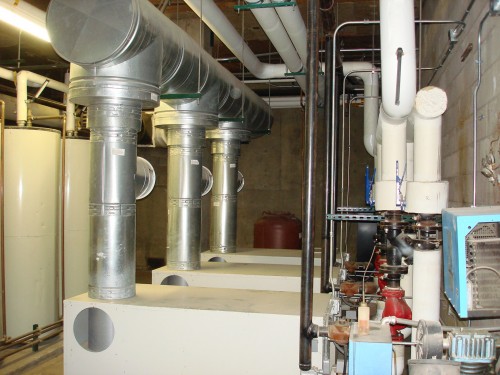
A heat pump can also be run in reverse, so you can move heat in either direction. These are the basic fundamentals of how most motel rooms are cooled AND heated. The very same device can be controlled forward for A/C and in reverse for heat.
The heat pump is a surprisingly efficient machine for moving heat, however there are some challenges to optimizing the energy it consumes in order to work. Most importantly, the temperature of the surroundings. If you’re trying to move heat into a place that is already extremely hot, the heat pump will have a very hard time trying to shed that excess heat on the receiving side. Similarly, if it has to pull heat from an extremely cold source, this doesn’t work so well either as there’s simply not much heat energy available. The examples here are moving heat from inside a building to the outside when the outside air temperature is 110 degrees. Or trying to heat your home with a heat pump when the outside air temperature is -10 degrees. Both scenarios are very difficult for a heat pump to work very efficiently.
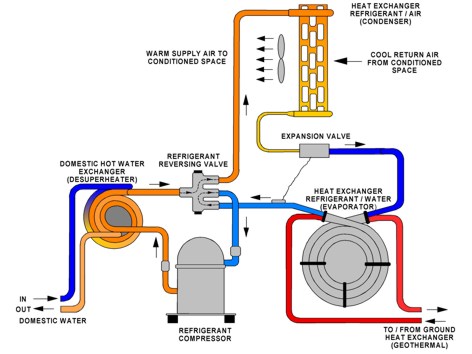
Let’s get to how geothermal fits into all of this. Most people conjure images of old faithful and bubbling hot springs or even smoldering volcanoes when they hear the word geothermal. While there are some instances of people harnessing the energy from these natural wonders, this is not what most geothermal systems are about. To put it simply, geothermal systems allow the heat pump to exchange heat with a constant and stable underground temperature instead of the wildly fluctuating outside air temperature.
The ground temperature below frost depth pretty much everywhere in North America runs at a constant temperature of around 56 degrees Fahrenheit. So the basic idea is that if you can exchange heat with the 56 degree ground, the heat pump has a much easier time moving that heat in all four seasons because it doesn’t have so much temperature to overcome in either direction. The results: energy efficiency. In addition, these systems are scalable, and therefore applicable to both small residential as well as larger commercial applications.
So why doesn’t everyone have a geothermal system in their buildings? Initial costs can be rather expensive, particularly if the site is not conducive for it. Geothermal loops require a large system of underground pipes to exchange the heat effectively with the ground. Some buildings don’t have the site space for this and other buildings may be on such solid rock, that you have to drill to get the systems in to the ground and this can be very costly.
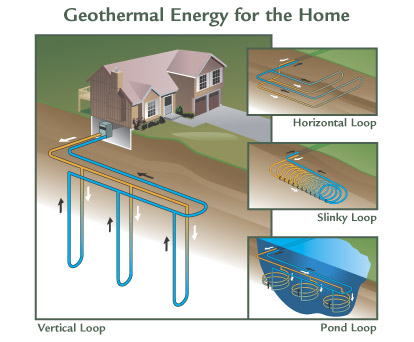
However, it can be done just about anywhere and if you have a site that is geo-friendly, it can be very cost effective over the life cycle of the building. An additional bonus about the underground pipes: no moving parts to go haywire. All of the equipment for the pump sits in the mechanical room and the geothermal loop can support a forced air or radiant HVAC system, just like any other heat exchange method.
So the recommendation? Definitely look into it. Any good geothermal contractor can come out and do a site assessment and tell you what your options are. And most can also give you a cost breakdown of the system over time. Exchanging heat with a constant temperature sink / source is just plain smart engineering. As long as you’ve got the site, it is not only going to save you money on your heating and cooling, but you will also have pride in knowing that you are doing the responsible thing for the lifetime of your project.
We have worked with a number of excellent geothermal contractors, so if you need more information for your project, give us a call or send us an e-mail and we can pair you with someone appropriate for your needs.


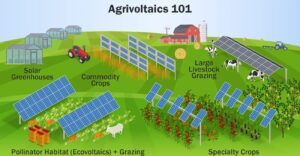
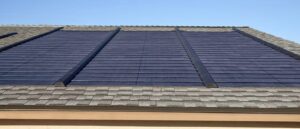
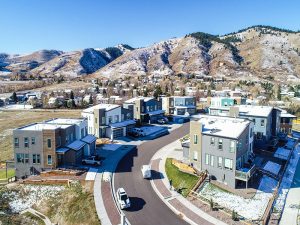






3 thoughts on “Consider Geothermal Heating and Cooling for any Project”
There is some speculation as to whether or not a geothermal heating/cooling system would fit on some lots. People tend to think that they have no room on their property to install such a system. However, there are several types of geothermal loop designs that could accomodate many different sized lots.
They sure do Ingram, but every climate will require a specific approach. this is why it is important to always have these systems engineered for a specific project because there is no one-size-fits-all solution.
Geothermal Heat Pumps work in any kind of climate !
Comments are closed.